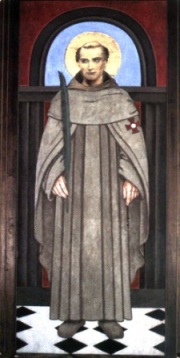St. Richard Reynolds, the Angel of Syon.

Today I want to bring the figure of a little-known holy martyr, who, to make matters worse, was long held as belonging to another religious order:
St. Richard Reynolds, brigidine martyr. May 4.
Richard was born into in 1490 in Devon, England. It was an excellent student of Arts and Philosophy of Cambridge , outstanding student and emeritus member of Corpus Christi College, where he graduated BA in Theology. From the studies, he went to the monastic life at the Abbey of Syion, from the Order of the Holy Saviour, founded by St. Bridget. It is considered one of the most brilliant theologians of the sixteenth century. It was a great preacher and wrote (though not preserved) a lot of sermons and theological treatises.
In 1534, when Henry VIII separated the Church, some of the monks of Syon were in favor of the separation, supporting the English king was the visible head of the Church of England. In other abbeys some priors forced all the monks and other monasteries to accept the idea of submission to the king. Others, loyal to the Church, refused to recognize the new title of king among them was from the beginning Richard, who used his word and pen to defend the faith. As a result, and reports of their brothers of the monastery, the King fixed his attention on the Syon Abbey and Richard.
In Syon Richard organized a meeting between Saint Thomas More (June 22), the leading opponent of the king on his assumption of the Supreme Governor of the Church, and Elizabeth Barton, the "Holy Maid of Kent", an English mystic known for its revelations and writings, convicted of "conspiring" against the king (apparently would have predicted the separation). Shortly before Thomas Cromwell, King’s minister, had visited Syon for accepting the oath of the Royal Supremacy of the monks (the king was very much interested by the prestige of the abbey), but a monk faithful to the Catholic faith slammed doors and not let them pass. Cromwell left two guards at the door of the monastic complex, to convince the monks and nuns, especially the Abbess (1). But none succeeded. Had to send the bishop of London, an enthusiast for the cause of Henry VIII to two clerics to convince the monks and nuns.
The more coherent monks were Richard and two others, whose last name where Whitford and Little. One of the guards of Cromwell blackmailed the first, saying that he would reveal he´s confidences with their penitents and flirting (fake, of course) with several ladies, but the monk did not backed. Knowing that his confession and spiritual direction monks were telling the faithful and the nuns who remain in the Catholic faith and did not obey the royal order, Cromwell sent to shut the confessional grille (2).
Being apart the nuns, would be easier to convince, so gathered in the chapter, with the presence of the Bishop of London and its clerics were asked to leave those who opposed the king’s supremacy, and to stay those who accepted . They all stood seated, which meant acceptance. And is that the nuns had been coaxed with the promise that if they agreed, they could continue the monastic life without problems. Only one nun named Agnes Smythe resisted and tried to convince the nuns do not accept, preventing men of Cromwell took the stamp of the abbess to seal the declaration of acceptance of the Royal Supremacy over the Church. Finally, all signed, except Richard Reynolds and monks previously mentioned, Whitford and Little, who we do not know his whereabouts. Richard was taken to Tyburn Tree, in London. Were he was imprisoned with : St. John Houghton, St. Robert Lawrence and St. Augustine Webster (the three on 4 May and 16 July), priors of the London Charterhouse, and Axholmey-Beauvalle respectively. For this reason it has long been held as a Carthusian, until the investigations deepened enough to clarify that it was Brigidine (3). With them there was also martyred, the priest of Isleworth, St Alexander Hailes (May 4).
They were dragged through the streets of London, hanged and the body of San Richard was shattered and pieces hanging from various parts of the city, as a warning. San Richard beatified on 1929 and in 1970 by Paul VI, along with other martyrs of England and Wales, and her feast is set for 4 May.
By Ramon Rabre (text) and Marco Antonio Martinez Ruvalcaba (translation)
(1) The Brigidine monasteries were mixed and both monks and nuns were subject to the Abbess, who represented Christ. should have twelve Priests brothers, like the apostles and 72 members, including nuns and monks, like the disciples. It is clear that this numbering was symbolic and not always achieved, either by default or by excess.
(2) The common use in this type of abbeys was that the confession was a hole in the wall with a grid, to supply two areas separate. On one side the monks, other nuns, and other holes to the church, the faithful external field.
(3) Interestingly, the Blesseds Brigidines, Ana Maria Erraux and Lilvina La Croix, martyrs of the French Revolution, in Valenciennes, were taken as the Ursulines nuns, for this same reason. Held on 23 October.
0 comentarios